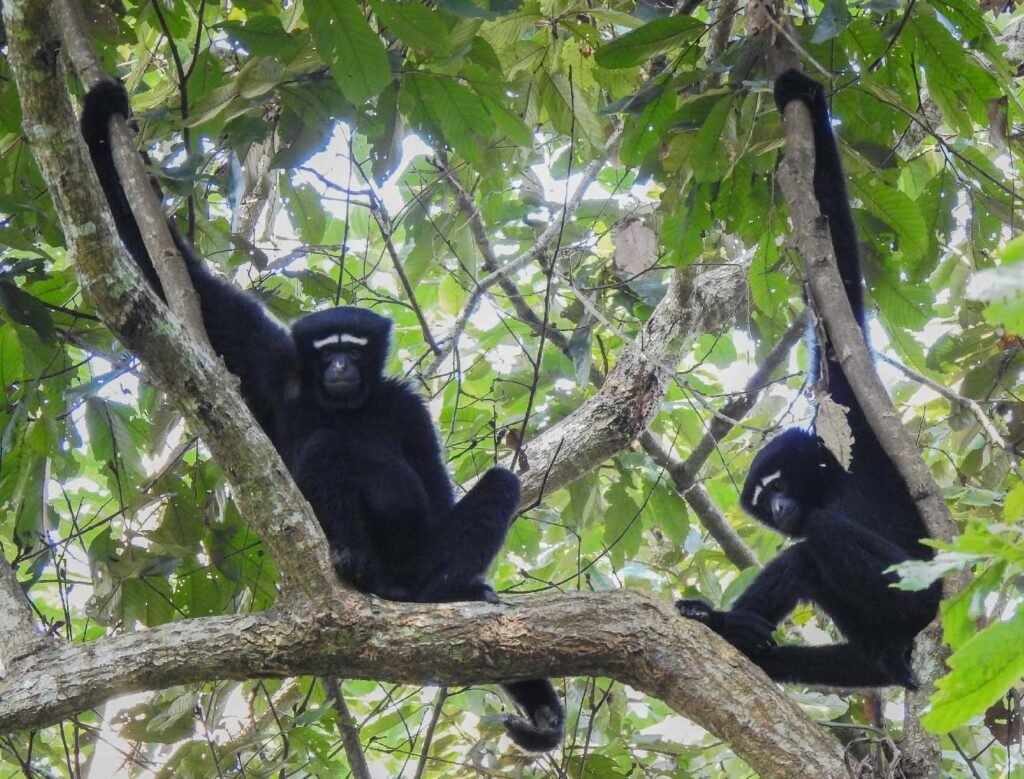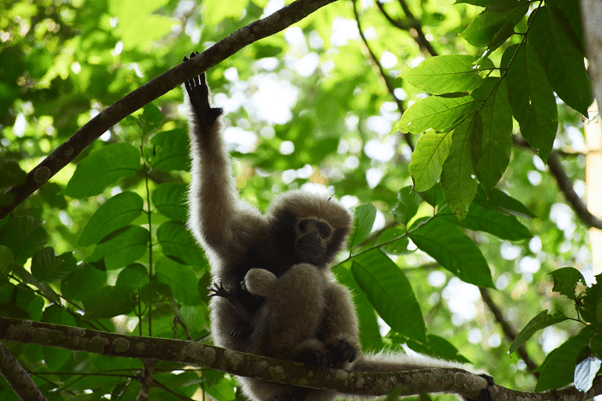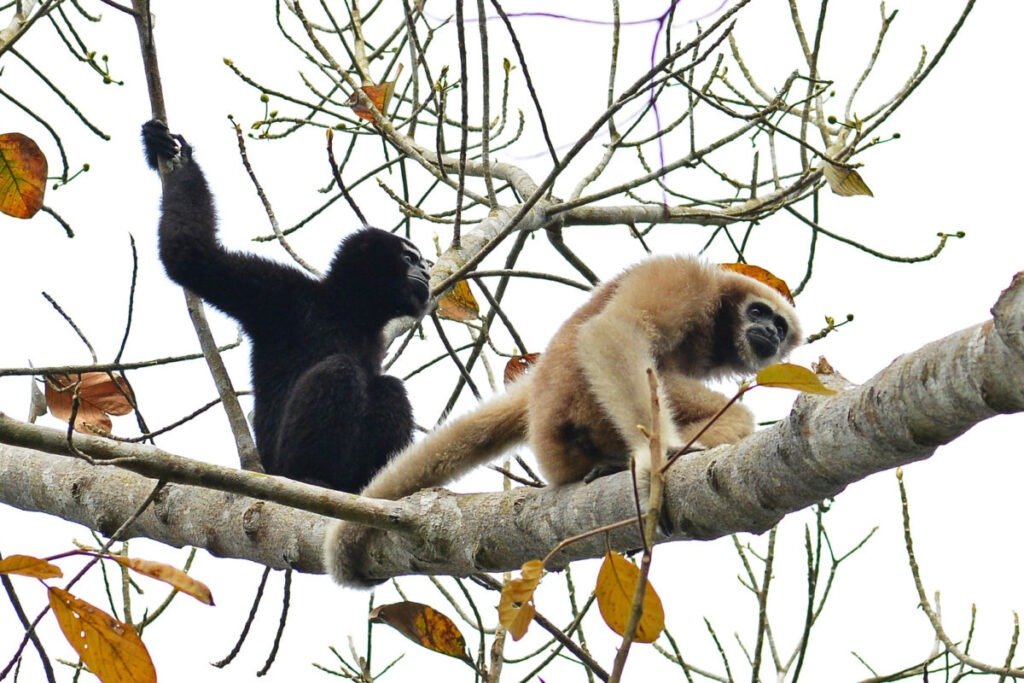High up in the emerald canopies of Assam’s rainforests, the haunting call of the Hoolock Gibbon echoes like a song from the past. As India’s only native ape species, the Hoolock Gibbon is both biologically unique and ecologically vital. In 2025, conservationists are racing against time to protect this endangered primate, focusing efforts on the Hoollongapar Gibbon Sanctuary in Jorhat district—one of the last remaining strongholds of these elusive tree-dwellers.
Who Are the Hoolock Gibbons?
The Hoolock Gibbons belong to the genus Hoolock and are characterized by their long arms, striking facial markings, and their signature loud, melodious calls. Unlike monkeys, they do not have tails and are true apes. In India, two species are found: the Western Hoolock Gibbon (Hoolock hoolock) and the Eastern Hoolock Gibbon (Hoolock leuconedys), with the former being more prominent in Assam. They are arboreal and diurnal, depending entirely on continuous forest cover for survival.
The Critical Role of Hoollongapar Gibbon Sanctuary
Spanning roughly 20 square kilometers, the Hoollongapar Gibbon Sanctuary is a patch of semi-evergreen forest nestled between tea gardens and human settlements. Despite its small size, it is home to the densest population of Hoolock Gibbons in India. In 2025, the sanctuary continues to serve as a biodiversity hotspot—not only for gibbons but also for stump-tailed macaques, Assamese macaques, and over 200 bird species.

Forest Fragmentation: The Biggest Threat
One of the gravest challenges facing them is habitat fragmentation. Over the years, the sanctuary has become an island of forest surrounded by agriculture and tea estates, cutting off natural corridors essential for gibbon movement and gene flow. This isolation threatens long-term genetic health and increases human-animal conflict. In 2025, conservationists have intensified efforts to restore these green corridors using native tree plantations and assisted regeneration.
Scientific Research and Monitoring
Research is the backbone of gibbon conservation. In recent years, teams from national and international universities have conducted extensive behavioral, ecological, and genetic studies in the Hoollongapar Sanctuary. In 2025, satellite mapping, acoustic monitoring, and camera traps have helped scientists track gibbon troop sizes, movement, and feeding habits. These studies aid in developing more targeted and effective conservation strategies.
Community Involvement and Education
Local communities play a crucial role in protecting them. Many residents living around the sanctuary belong to indigenous groups who hold traditional respect for forest life. Conservation groups in 2025 have scaled up educational campaigns in schools, held eco-camps, and created jobs as eco-guides and forest patrollers. This model of community-based conservation ensures long-term stewardship of the land and its wildlife.

Role of NGOs and Forest Department
The Assam Forest Department, in collaboration with NGOs such as Aaranyak and Wildlife Trust of India, has spearheaded several conservation programs. These include anti-poaching patrols, awareness drives, and reforestation campaigns. In 2025, the introduction of a mobile forest clinic has helped treat injured or stranded wildlife near the sanctuary, showing a humane approach to conservation management.
New Conservation Initiatives in 2025
A major win in 2025 has been the launch of the “Green Bridges Project,” a corridor restoration program connecting Hoollongapar with nearby forest patches. Supported by the Ministry of Environment and Forests, this project involves planting over 50,000 native trees, building canopy bridges for arboreal species, and legally protecting buffer zones. A mobile app now enables citizen scientists to report gibbon sightings and help monitor forest health.
Challenges to the Long-Term Survival of Gibbons
Despite progress, many hurdles remain. Encroachment, illegal logging, and lack of forest connectivity continue to threaten gibbon populations. Climate change poses a rising risk, altering flowering and fruiting cycles critical to their diet. Additionally, being slow breeders—producing only one offspring every 2–3 years—makes recovery of their population painstakingly slow. In 2025, the call for national-level attention and funding has grown stronger.
The Global Significance of Saving India’s Only Ape
Protecting the Hoolock Gibbon is not just about saving a single species—it is about preserving an entire ecosystem. As canopy-dwellers, gibbons play a key role in seed dispersal, maintaining forest health and diversity. Their conservation is also a measure of how seriously India takes its commitment to biodiversity under international treaties. In 2025, the Hoolock Gibbon has become a symbol of Northeast India’s fragile yet resilient forests.

The Hoollongapar Gibbon Sanctuary stands as a living testament to what focused conservation can achieve. In 2025, thanks to the dedication of scientists, forest officials, and local communities, the haunting songs of the Hoolock Gibbons still echo through Assam’s treetops. But to ensure that future generations can hear them too, the momentum must not falter. Saving the Hoolock Gibbon is no longer an option—it is an urgent responsibility, one that speaks for the silent forests of India.












